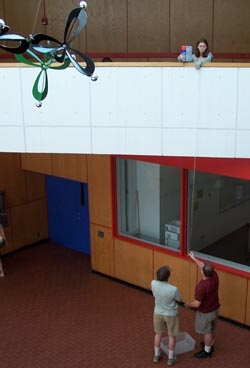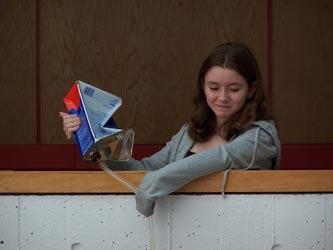What it shows:
This is a concept question relating to Pascal's cask-bursting experiment. Imagine the experiment inverted—literally! Attach a 20-ft length of tubing to the opening of a can full of water. Turn the can upside down and raise it high. Will the water stay in the can, or will it run out? Will atmospheric pressure hold up the column of water in the tubing? What will happen? Have the class vote.

How it works:
You may wish to introduce (obfuscate) the experiment with the old "inverting the water glass" trick in which the water stays put in the glass. Different from that result, here gravity does her thing and the water runs out.
As the water empties out of the can, a partial vacuum is left behind.1 Atmospheric pressure surrounding the can causes it to collapse.

Setting it up:
The "Hi-Jacker" lift will raise you to the required height in the lecture hall. Make sure you have a pan below to catch the water. The 1-gallon size can works well, but we're looking for a source of larger cans.
Comments:
For this experiment to work, you must use tubing with thick walls—Tygon® R-3603, vacuum rated, with 5/8" OD with a 3/16" wall does the trick. Repeat the experiment with flimsy rubber tubing, and the tubing wall will simply collapse and pinch off the water flow.
The experiment can be used to discuss how mother nature has solved a similar problem in giraffes—the walls of the blood vessels in the long neck must be strong enough to prevent a similar collapse when the giraffe raises its head up high. Furthermore, although the giraffe's heart must be strong to pump blood through such long carotoid arteries (to overcome Poiseuille's law of resistance to flow), the vertical height doesn't impose an additional burden. This is because the cardiovascular system is closed and acts like a siphon (the fluid in a siphon is gravitationally balanced between two points in the siphon at the same height).2 One could demonstrate this with a long closed loop of Tygon® tubing filled with water. If done with a long loop of thin-walled rubber tubing, the tubing at the top of the loop will collapse while the hydrostatic pressure at the bottom will cause the walls to bulge—something to be avoided in the cardiovascular system.
1 Hanging the same water-filled hose from a vacuum gauge (instead of the can) gave a reading of 1/2 atmosphere.
2 J.W. Hicks and H.S. Badeer, "Siphon mechanism in collapsible tubes: application to circulation of the giraffe's head," Am. J. Physiol. (256) R567-R571, 1989.
A thank you to Prof Amir Jacoby (Harvard) for suggesting the inverted can puzzler and to Prof Thomas Greenslade (Kenyon) for the Pascal reference, which appears in his article "19th century textbook illustrations (XXII)," TPT 16(4), 228. Below is a copy (from Thomas's article) of an illustration from Amédée Guillemin, Les Phénomènes de la Physique (Libraire de L. Hachette et Cie., Paris, 1868) p. 79.
